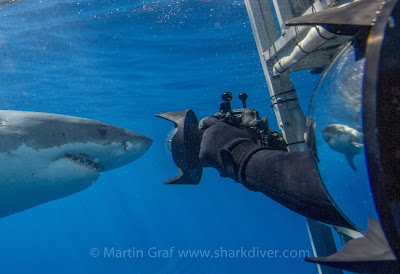Is cage diving safe?
A lot of you have seen the news coverage of 2 recent cage diving incidents and are wondering, “Is cage diving really safe?”
First of all I want to point out that neither of these incidents happened involved our company. We have been operating safe and sane shark dives for 16 years, without any incidents.
In the latest video you can see that the shark is going after a hang bait that is just laying in front of the cage. This is mistake by the bait handler. The bait was too close to the cage and should have been removed. Excerpt from the regulations for Guadalupe: The permit holder shall ensure that the bait line is immediately removed from the water if the white shark following the bait approaches within 6.5 feet (2 m) of the vessel.
When the shark was going after a bait, it rolled it’s eyes back and lunged for the bait. When it did that, it was essentially blind and it’s momentum carried it into the cage. Since it can’t swim backwards, it just started thrashing around blindly, eventually coming out of the top of the cage.
There is nothing wrong with using hang-baits. Responsible use of hang-baits actually enhances safety, as it allows us to direct the shark. The shark typically follows the bait and when it lunges for it, the follow through is in the same direction. Proper use allows us to lead the shark parallel to the cage instead of into it, as happened in the video above.
You don’t have to have the bait close to the cage to get great shots.
In addition to adhering to all the established safety standards, our cages are made out of round tubing which is both stronger than the square one and safer for the sharks, since it doesn’t have any sharp corners. We also only use surface cages with a redundant air supply, that are securely attached to our vessel.
Back to the general safety question. While nothing is ever 100% safe, so far in innumerable cage dives around the world, there have been zero fatalities, which is to say, it is far safer than recreational SCUBA diving.
Let’s go shark diving!
Cheers,
Martin Graf
CEO
Shark Diver
About Shark Diver. As a global leader in commercial shark diving and conservation initiatives Shark Diver has spent the past decade engaged for sharks around the world. Our blog highlights all aspects of both of these dynamic and shifting worlds. You can reach us directly at staff@sharkdiver.com.



.jpg)
